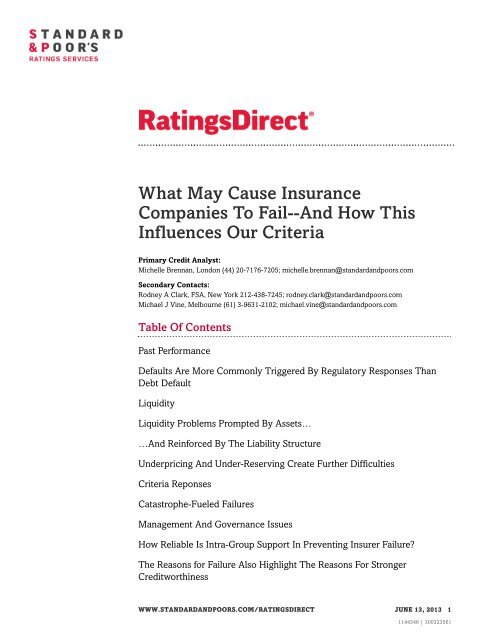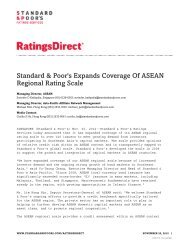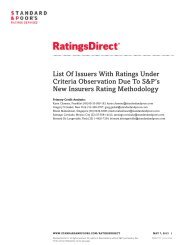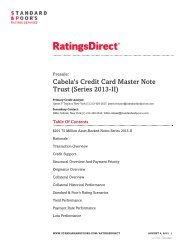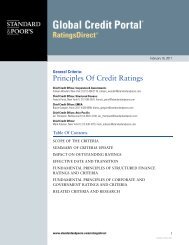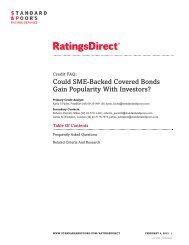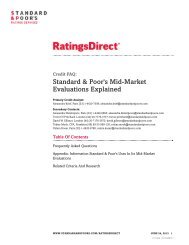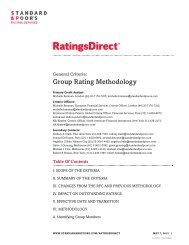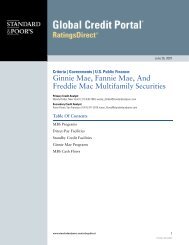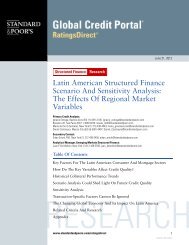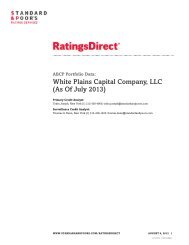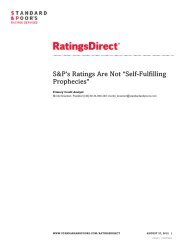What May Cause Insurance Companies To Fail ... - Standard & Poor's
What May Cause Insurance Companies To Fail ... - Standard & Poor's
What May Cause Insurance Companies To Fail ... - Standard & Poor's
Create successful ePaper yourself
Turn your PDF publications into a flip-book with our unique Google optimized e-Paper software.
<strong>What</strong> <strong>May</strong> <strong>Cause</strong> <strong>Insurance</strong><strong>Companies</strong> <strong>To</strong> <strong>Fail</strong>--And How ThisInfluences Our CriteriaPrimary Credit Analyst:Michelle Brennan, London (44) 20-7176-7205; michelle.brennan@standardandpoors.comSecondary Contacts:Rodney A Clark, FSA, New York 212-438-7245; rodney.clark@standardandpoors.comMichael J Vine, Melbourne (61) 3-9631-2102; michael.vine@standardandpoors.comTable Of ContentsPast PerformanceDefaults Are More Commonly Triggered By Regulatory Responses ThanDebt DefaultLiquidityLiquidity Problems Prompted By Assets……And Reinforced By The Liability StructureUnderpricing And Under-Reserving Create Further DifficultiesCriteria ReponsesCatastrophe-Fueled <strong>Fail</strong>uresManagement And Governance IssuesHow Reliable Is Intra-Group Support In Preventing Insurer <strong>Fail</strong>ure?The Reasons for <strong>Fail</strong>ure Also Highlight The Reasons For StrongerCreditworthinessWWW.STANDARDANDPOORS.COM/RATINGSDIRECT JUNE 13, 2013 11144346 | 300323561
Table Of Contents (cont.)Related Criteria And ResearchWWW.STANDARDANDPOORS.COM/RATINGSDIRECT JUNE 13, 2013 21144346 | 300323561
<strong>What</strong> <strong>May</strong> <strong>Cause</strong> <strong>Insurance</strong> <strong>Companies</strong> <strong>To</strong><strong>Fail</strong>--And How This Influences Our CriteriaAs risk-bearing institutions, insurers can, and do, fail if risks are not managed adequately, even though the incidence offailure has in general been low. For this reason, it's worthwhile to look at the recurring issues that have caused, and stillare causing, failures of rated and unrated insurers and explain how our observations inform our ratings criteria. Whenwe refer to insurer failures, we are talking about company defaults, liquidations, or regulatory takeovers--or "near miss"situations where these would have occurred if the company had not received external support. In this article, weconsider cases dating back as far as the 1980s because considering a shorter time frame of events can give an overlyoptimistic view of the strength of the sector. Since the 1980s, we have seen waves of failures that have informed ourcriteria developments, and have also influenced the way that many insurance companies are managed. In many casesof distress or failure that we have seen over this time, more than one of the following key factors was present, andoften they reinforced each other:• Poor liquidity management;• Under-pricing and under-reserving;• A high tolerance for investment risk;• Management and governance issues;• Difficulties related to rapid growth and/or expansion into non-core activities; and• Sovereign-related risks.Support--whether from another part of a group or from a government body--has, in our opinion, prevented the failureof several distressed insurance companies over the past decade. Assessing the likelihood of receiving such support istherefore a crucial feature of our rating methodology.Overview• Case history provides many examples of insurer failures caused by a select few recurring themes.• These examples have informed our criteria over the past two decades--including our new insurance criteriapublished on <strong>May</strong> 7, 2013 -and, by contrast, highlight how insurers can achieve better creditworthiness.• Liquidity issues spurred by problem assets and heightened by weak liability structures in times of stress havehistorically been a main cause of insurer failure.• Even with improvements in how companies manage liquidity and reserving, management and governanceissues continue to prompt insurance distress, and underpricing and managing rapid growth continue to be keyrisks.• Group support has historically buoyed many insurers and remains a key component in the likelihood of failure.• Those insurers most likely to run into difficulties lack the capitalization, prudent risk management, and solidunderwriting and reserving strategies displayed by their more resilient peers.On <strong>May</strong> 7, 2013, we published several new criteria articles for assigning ratings to insurance companies (see "Insurers:Rating Methodology," "Enterprise Risk Management," "Group Rating Methodology," and "Methodology For LinkingShort-Term And Long-Term Ratings For Corporate, <strong>Insurance</strong>, And Sovereign Issuers," all published onWWW.STANDARDANDPOORS.COM/RATINGSDIRECT JUNE 13, 2013 31144346 | 300323561
<strong>What</strong> <strong>May</strong> <strong>Cause</strong> <strong>Insurance</strong> <strong>Companies</strong> <strong>To</strong> <strong>Fail</strong>--And How This Influences Our CriteriaRatingsDirect). Parts of the new criteria address what we consider as the key causes of insurer distress, and include theexpansion of country and risk analysis in our <strong>Insurance</strong> Industry And Country Risk Assessment (IICRA), an enhancedliquidity analysis, capital metrics that focus more on asset-liability risks, and the larger role for enterprise riskmanagement (ERM) for insurers with complex risks.More idiosyncratic causes of failure, such as specific issues with management and governance, are the focus of ourcriteria for assessing the effectiveness of management and of risk management structures. In compiling our revisedGroup Rating Methodology, we considered cases where subsidiaries collapsed or where, in our opinion, they wouldhave done so in the absence of group support.Past PerformanceSeveral periods of heightened stress spanning the past three decades, which resulted in an increased number ofinsurance company failures, inform our criteria. A number of these stress periods were more industry-specific thanmacroeconomic, although local economic conditions reinforced the Japanese situation outlined below, and sovereigndistress led to the Russian example:• 1984-1989: A number of predominantly casualty insurers in the U.S., including Mission <strong>Insurance</strong> Co. and TransitCasualty <strong>Insurance</strong> Co., became insolvent as loss reserves proved deficient following a period of inadequate pricingindustrywide;• 1992-1994: Several significant U.S. life insurers, including Executive Life <strong>Insurance</strong> Co., Mutual Benefit Life<strong>Insurance</strong> Co., and Confederation Life <strong>Insurance</strong> Co., failed due to a combination of illiquid asset concentrationsand a lack of liquidity to meet maturing liabilities;• 1999: The Russian Federation's selective default on some of its bonds led to severe pressure on the country'sinsurers holding these bonds, amounting to technical insolvency for some smaller insurers.• 2000: Japanese life insurers, including Chiyoda Mutual Life <strong>Insurance</strong> Co., Kyoei Life <strong>Insurance</strong> Co., and <strong>To</strong>hoMutual Life <strong>Insurance</strong> Co., voluntarily entered rehabilitation proceedings or closed their insurance business underregulatory order because guaranteed interest rates on savings products were no longer sustainable given lowinterest rates in Japan; and• 2002-2005: Several international non-life insurers and reinsurers failed, including Mutual Risk Management Ltd.,Trenwick Group Ltd., GLOBALE Rueckversicherungs-AG, and Converium Reinsurance (North America) Inc.,predominantly due to deficient reserves for casualty lines following a period of inadequate pricing industrywide,compounded by weak risk management.Perhaps surprisingly, the global financial crisis that began in 2007 failed to trigger a wave of life and non-life insurerdefaults among rated companies. In fact, not one significant insurer that <strong>Standard</strong> & <strong>Poor's</strong> rated at the time (outside ofthe bond and mortgage insurance sectors) has defaulted due to the financial crisis. Insurers have defaulted or comeunder stress because of problems largely outside of their traditional insurance businesses (such as expansion intofinancial derivatives for American International Group Inc. [AIG]). Certain bond and mortgage insurers have alsodefaulted. However, these two sectors are outside the scope of the new insurance criteria (see "Bond <strong>Insurance</strong> RatingMethodology And Assumptions," Aug. 25, 2011, and "U.S. Mortgage Insurer Sector Outlook Remains Negative--AndThe Clock's Ticking," published on March 1, 2012).WWW.STANDARDANDPOORS.COM/RATINGSDIRECT JUNE 13, 2013 41144346 | 300323561
<strong>What</strong> <strong>May</strong> <strong>Cause</strong> <strong>Insurance</strong> <strong>Companies</strong> <strong>To</strong> <strong>Fail</strong>--And How This Influences Our CriteriaDefaults Are More Commonly Triggered By Regulatory Responses Than DebtDefaultWe observe that while corporate and bank failures are usually visible through the incomplete or untimely payment onall or some financial obligations, including debt restructurings, an insurance company failure most often becomesapparent when the regulator takes action because the insurer's financial position has become untenable. <strong>Standard</strong> &<strong>Poor's</strong> represents this by moving the issuer credit rating or insurance financial strength rating to 'R' (regulatorysupervision), equivalent to a 'D' (default) in our ratings performance statistics. The timeliness element of obligations ininsurance policies is typically much less clearly specified than for debt obligations. Also, insurers tend to have low debtburdens, but high policy obligations. So, nonpayment of a debt obligation generally isn't what prompts a default.In "<strong>Standard</strong> & <strong>Poor's</strong> Ratings Definitions", published June 22, 2012, we define an 'R' issuer credit rating as follows: "Anobligor rated 'R' is under regulatory supervision owing to its financial condition. During the pendency of the regulatorysupervision the regulators may have the power to favor one class of obligations over others or pay some obligationsand not others." Following this regulatory intervention, an insurance company typically defaults on some or allfinancial obligations.Liquidity<strong>Insurance</strong> companies try to match maturity profiles of assets and liabilities. Yet, several insurance failures have arisenfrom concentrations in illiquid assets matched by liability structures that accelerated in a time of stress. <strong>Insurance</strong>operating companies traditionally have less risky liquidity structures than banks or certain types of corporates, but alarge number of past failures are attributable to poor liquidity management. For example, a stream of U.S. lifeinsurance failures in the early 1990s (see table 1) reflected illiquid assets that could not meet liabilities that came due.The case was one of a "run on the bank" type scenario, where some customers looked to withdraw business from thecompanies due to concerns about their creditworthiness, which only served to reinforce the weaknesses.Table 1Asset Concentrations: U.S. Life Assurance <strong>Fail</strong>ures 1991-1994First Executive Corp.Executive Life <strong>Insurance</strong> Co. of CAFirst Capital Holdings Corp.Mutual Benefit Life <strong>Insurance</strong> Co.Monarch Life <strong>Insurance</strong> Co.Kentucky Central Life <strong>Insurance</strong> Co.Confederation Life <strong>Insurance</strong> Co.Liquidity Problems Prompted By Assets…In the case of Executive Life <strong>Insurance</strong> Company of New York, investments in high-yield bonds and hybrid capitalsecurities lost market value and became less liquid on the secondary market. Mutual Benefit's illiquid investments wereWWW.STANDARDANDPOORS.COM/RATINGSDIRECT JUNE 13, 2013 51144346 | 300323561
<strong>What</strong> <strong>May</strong> <strong>Cause</strong> <strong>Insurance</strong> <strong>Companies</strong> <strong>To</strong> <strong>Fail</strong>--And How This Influences Our Criteriapredominantly real estate developments, including several intercompany loans. Real-estate equity investments alsodamaged the value and liquidity of Monarch Life's assets, and, in 1992, the insurer had to stop writing new life andannuity business. Around the same time, Kentucky Central and Confederation bore the brunt of large exposures tomortgage loans on commercial real estate, including construction loans on new developments and high loan-to-valuemortgages, which performed poorly following the 1991-1992 U.S. recession.Our capital model, introduced in 1994, has been refined over time to reflect experience of default rates on certaintypes of bonds and portfolio losses. One change, for example, was the increased loss experience data for commercialmortgages. The model applies substantial risk charges for speculative-grade bonds and for nonperforming real estateloans. Following the market downturn in 2007-2008, we introduced refined security-specific recovery analytics forcertain parts of insurance investment portfolios, such as structured finance assets.In 2012, we updated our capital model charges for commercial loan holdings of life insurers, adding greaterdifferentiation by loan quality characteristics and applying a commensurate risk charge to construction loans. Thischange aims at identifying and taking into account risk in the loan portfolios before losses emerge.The risk position factor within our new criteria framework takes account of the following heightened investment risks:• Outsized asset concentrations by single obligor or asset class; and• Outsized exposure to high risk assets.In this way, we seek to reflect the potential for increased volatility beyond what is modeled for under our capitalcriteria.…And Reinforced By The Liability StructureThese liquidity-related failures also highlighted to us the different ways in which certain types of policyholders react intimes of stress. Withdrawal rates spike for certain types of products, and we reflected this in the adjustments that wemade to our liquidity criteria (see below). In the case of the U.S. failures, the primary liquidity strains came fromaccelerated institutional Guaranteed Investment Contract (GIC) surrenders, while surrenders of fixed annuities andinterest-sensitive life insurance provided secondary constraints.Surrender rates can work against insurer creditworthiness in other ways, too. In Japan, low interest rates led to lowerpolicy surrender rates, reinforcing the effect of negative product spreads that reduced life insurer profitability, and, insome cases, lowered solvency. While the problems encountered by Japanese life insurers were not due to liquidity perse, they do highlight how surrender rates can affect the viability of business models.We introduced liquidity criteria for North American life insurers in 1994 and we have updated it on several occasionsup to 2004, prior to the introduction of our new criteria in <strong>May</strong> 2013. Our criteria measures liquid assets against liquidliabilities, applies haircuts to reflect the risks associated with lower-rated bond holdings, and gives no credit forliquidity on commercial mortgages. The criteria also apply liquidity charges for institutional GICs that reflect the veryhigh surrender risk.WWW.STANDARDANDPOORS.COM/RATINGSDIRECT JUNE 13, 2013 61144346 | 300323561
<strong>What</strong> <strong>May</strong> <strong>Cause</strong> <strong>Insurance</strong> <strong>Companies</strong> <strong>To</strong> <strong>Fail</strong>--And How This Influences Our CriteriaU.S. insurance companies faced another round of liquidity-driven problems in 1999. Again, this was due to acceleratingsurrender demands, particularly on short-term GICs that were mainly invested in by mutual funds (see table 2).Table 2Accelerating Surrender Demands: 1999GenAmerica Financial Corp.General American Life <strong>Insurance</strong> Co.ARM Financial Group Inc.Integrity Life <strong>Insurance</strong> Co.RGA Reinsurance Co.High Surrender Demands: Case HistoriesIn 1995, General American entered into an arrangement with Integrity Life <strong>Insurance</strong> Co., a unit of ARMFinancial, whereby General American would distribute funding agreements designed by ARM and reinsure 50%of the funding agreement business to Integrity. Reinsurance Group of America Inc. (RGA) agreed to reinsure 25%of General American's retained risk under the funding agreement program. By 1999, the funding agreementbusiness accounted for 95% of Integrity's insurance liabilities, demonstrating that risk concentration and theeffect of rapid growth also contributed to the company's distress.Due to a rise in interest rates, ARM's shareholders' equity decreased by about 50% between Dec. 31, 1998, andJune 30, 1999. On July 29, 1999, the company announced that it would restructure its funding agreementbusiness and seek a buyer. Surrenders on the funding agreements, which allowed investors (mainly sophisticatedmutual funds) to put the funding agreements to the company with seven days' notice, increased significantly dueto the announcement and subsequent lowering of the ratings on ARM. On Aug. 3, 1999, General Americanrecaptured the reinsurance from Integrity, which forwarded $3.4 billion of liabilities and related assets ontoGeneral American's balance sheet.On Aug. 10 the same year, General American was taken under administrative supervision by the MissouriDepartment of <strong>Insurance</strong> because of its inability to meet high surrender demands. On Aug. 20, a similar actionwas taken on Integrity by the Ohio <strong>Insurance</strong> Department at the company's request because of insufficientliquidity to meet its remaining obligations. RGA returned $1.4 billion of liabilities and $1.8 billion of assets toGeneral American related to the funding agreement retrocession agreement, and other agreements related to itslegacy as successor to the General American Reinsurance business. Metropolitan Life <strong>Insurance</strong> Co. (MetLife)stepped in to acquire both General American and RGA one week later.We revised our liquidity criteria for life insurers in North America in 2000 because of these case histories toincorporate an assumption that any GIC that can be put to an insurer in less than 60 days will, in effect, beimmediately due. Any insurer currently issuing contracts with such features would, therefore, need to hold substantialliquid assets to be assigned an investment-grade rating by <strong>Standard</strong> & <strong>Poor's</strong>. In our new criteria framework, we haveimplemented a simplified version of the North American liquidity ratio for insurers other than North American lifeoperating companies.WWW.STANDARDANDPOORS.COM/RATINGSDIRECT JUNE 13, 2013 71144346 | 300323561
<strong>What</strong> <strong>May</strong> <strong>Cause</strong> <strong>Insurance</strong> <strong>Companies</strong> <strong>To</strong> <strong>Fail</strong>--And How This Influences Our CriteriaUnderpricing And Under-Reserving Create Further DifficultiesIn our observation, poor pricing strategies can lead to short-term business expansion at the expense of sustainablefinancial positions. Underpricing, for one, leads to negative business margins. The problem is compounded if poorpricing also leads to poor estimations of reserving needs, or if it compromises an insurer's capacity to reserveadequately for future claims.We believe that poor policy design and pricing are the root of the issue, which are often by-products of insufficientexperience in a particular business line and exacerbated by competitive pressures.From California…The case of the Californian workers' compensation market in the 1990s shows how aggressive market competitivedynamics can lead to a series of failures by encouraging prices and reserving that don't adequately reflect product risk(see table 3 for the resulting failures).Table 3The Impact Of Californian Workers' Compensation: 2000-2001Symons International Group Inc.Superior National <strong>Insurance</strong> Group Inc.Superior National <strong>Insurance</strong> Co.Reliance Group Holdings Inc.Reliance <strong>Insurance</strong> Co. of PAFremont Indemnity Co.Legion Indemnity Co.The state of California deregulated rates for workers' compensation in 1995, which was followed by a period of intensecompetition and drive for market share. The underpricing and inadequate reserving that ensued came to light late inthe decade and resulted in several companies that were heavily concentrated in the market becoming insolvent.We responded to these events by fine-tuning our criteria so that it included a reserving model to identify reservingdeficiencies. We also embedded into our methodology an increased focus on assessing policy features that couldpotentially lead to inadequate reserving. This included greater questioning of actuarial reports and identification ofpolicy underpricing in several markets globally in the late 1990s and into the early 2000s. We continue to monitor thisaspect today. For example, the IICRA, included in our new criteria, addresses emerging pricing pressures.…<strong>To</strong> inadequate pricing and reserving globallyThe turn of the century brought with it continuing pricing and reserving obstacles for insurers in certain marketsglobally.Several U.K. life insurers displayed increased reserving needs following the market downturn in the early 2000s. Thiscame as an upshot of the earlier underpricing of guarantees embedded into products and the overuse of equities toback policy liabilities. The only U.K. life insurance failure during this period, that of Equitable Life, was for reasonsspecific to the insurer, but the sector as a whole exhibited greater weakness for several years.WWW.STANDARDANDPOORS.COM/RATINGSDIRECT JUNE 13, 2013 81144346 | 300323561
<strong>What</strong> <strong>May</strong> <strong>Cause</strong> <strong>Insurance</strong> <strong>Companies</strong> <strong>To</strong> <strong>Fail</strong>--And How This Influences Our CriteriaGlobally, insurance companies failed due to industrywide underpricing in casualty lines and the resulting inadequatereserves (see table 4). The affected companies comprised primary insurers (Acceptance and Frontier) and reinsurers(Mutual Risk, Globale, Trenwick and PMA) that covered these lines. The case of the reinsurers was characterized bytheir expectation that they had provided very low risk financial or finite reinsurance services. These activities provedhigher risk and this finally had to be offset by significant reserve strengthening, which ultimately rendered thecompanies insolvent.Table 4Underpricing And Reserving Problems: 2002-2004Mutual Risk Management Ltd.GLOBALE Rückversicherungs AGTrenwick Group Ltd.Acceptance <strong>Insurance</strong> Cos. Inc.Acceptance <strong>Insurance</strong> Co.PMA Capital <strong>Insurance</strong> Co.Frontier <strong>Insurance</strong> Co.Another example of an insurance company that was subjected to regulatory takeover following inadequate reservingwas Singaporean Cosmic <strong>Insurance</strong> in 2002. Its strategy of soft pricing and reserving initially helped the companygrow rapidly in its key competitive markets (motor and fire insurance and performance bonds). The strategy ultimatelyproved inadequate in the face of growing payments to policyholders, driven by court rulings on payments that werehigher than anticipated. It experienced serious operational difficulties, including continued losses arising from higherclaims, large uncollected premium balances, and inadequate loss reserves. Cosmic's demise was also spurred by anaggressive investment profile that was high in equities and by the concentration of its business lines. It did raiseadditional capital to strengthen its financial position, but the amount raised was insufficient to restore the regulatorysolvency margin for its domestic insurance policies that the <strong>Insurance</strong> Act required it to maintain. Cosmic had to stopwriting new business or accepting renewals in 2002.In Taiwan, where the operating environment is highly competitive and most insurance companies are relatively smallin capital size, two insurance companies have in the past decade been taken over by the regulator due to unsustainablefinancial positions. The first, Kuo Hua <strong>Insurance</strong> Co. Ltd., a non-life insurer, was taken over in 2005 because of itsfragile capitalization. We had assigned a 'CCCpi' public information rating to the company in 2001, which we loweredto 'R' following the regulatory takeover.The second, Kuo Hua Life <strong>Insurance</strong> Co. Ltd., was taken under regulatory control because of negative reported capitalin 2009. Both companies had weak and deteriorating financial positions over a decade due to their small scale ofoperations and under-reserving issues. Kuo Hua Life also suffered a negative spread burden due to its asset-liabilitymismatch risks. We withdrew our 'CCCpi' ratings on the company in June 2004 because of insufficient publicinformation. Taiwanese life insurers' current profitability remains modest because of the weight of legacy-guaranteedproducts set against a backdrop of prolonged low interest rates.WWW.STANDARDANDPOORS.COM/RATINGSDIRECT JUNE 13, 2013 91144346 | 300323561
<strong>What</strong> <strong>May</strong> <strong>Cause</strong> <strong>Insurance</strong> <strong>Companies</strong> <strong>To</strong> <strong>Fail</strong>--And How This Influences Our CriteriaThe case of JapanThe collapse of Nissan Mutual Life, Japan's 16th-largest life insurer, in April 1997, showed that Japanese life insurancecompanies could fail. This bankruptcy, the first in the industry's history, triggered a loss of confidence, resulting in asharp increase in surrenders for most insurers in the subsequent 12 months. Because no regulatory or industry schemeexisted to protect policyholders, suspicions about the credibility of life insurers spread rapidly, particularly amongordinary individual policyholders. Subsequently, several then-rated insurers, including Chiyoda Mutual Life <strong>Insurance</strong>Co., Kyoei Life <strong>Insurance</strong> Co., and <strong>To</strong>ho Mutual Life <strong>Insurance</strong> Co., voluntarily entered rehabilitation proceedings orclosed their insurance business under regulatory order. These failures were primarily the result of industry-wideafflictions. Japanese life business was being written at negative spreads, so insurers were taking on investment risk tocompensate, creating higher risk profiles. High payout rates (typically of greater than 95%) were common and wereused to support the mutual business models. However, they left insurers with thin balance sheets and inadequatecapital resources.Criteria ReponsesOur various criteria enhancements since these events aim to address the negative effects of market pricing andreserving dynamics in several ways. First is the IICRA, which takes account of industry underwriting standards andwhich could be adjusted to reflect poor market operating conditions. Our entity-specific assessments also addressnegative trends that affect only a segment of the market. As appropriate, our assessment of companies concentrated ina market sector that is experiencing tough competition or narrow-margin prices would likely include a negativebusiness risk profile (BRP) adjustment to reflect the risks associated with the competitive position, as well as a negativescore for additional sources of capital volatility. This would weigh on the BRP and the financial risk profile (FRP), andtherefore on the ratings.The IICRA can also capture contributors to insurer distress such as distortionary legal restrictions on investments,government-imposed controls, and problems with the regulatory framework.Catastrophe-Fueled <strong>Fail</strong>uresAlthough certain insurance companies are exposed to specific catastrophes, such as floods and hurricanes, we haveseen few failures due to the occurrence of such events. That said, ultimate losses may have been greater than insurershad anticipated.One insurer that came near to failure following the terrorist attack on the World Trade Center (WTC) in 2001, wasJapanese Taisei Fire & Marine <strong>Insurance</strong> Co. Ltd. The losses incurred exceeded Taisei Fire's capital such that itmerged with Sompo Japan <strong>Insurance</strong> Inc. soon after, in December 2002. However, in our view, the distress at TaiseiFire cannot be solely attributed to the size of its exposure to a specific catastrophic event, but rather to the riskmanagement issues that allowed such an exposure to build.New Zealand's Christchurch and Canterbury region earthquakes in September 2010 and February 2011 were againunexpected, and therefore the effects on insurers would have been difficult to anticipate. The region is not consideredWWW.STANDARDANDPOORS.COM/RATINGSDIRECT JUNE 13, 2013 101144346 | 300323561
<strong>What</strong> <strong>May</strong> <strong>Cause</strong> <strong>Insurance</strong> <strong>Companies</strong> <strong>To</strong> <strong>Fail</strong>--And How This Influences Our Criteriaa traditional earthquake zone and, therefore, was not modeled by the industry to the sophistication of other identifiedcatastrophe zones in New Zealand. Some insurers were therefore hit heavily by the cost of the earthquakes, due totheir concentration in the region, the accumulation of multiple events in a short period, and inadequate reinsurancepurchase.Small entrepreneurial insurer Western Pacific <strong>Insurance</strong> Ltd. was placed into liquidation effective April 2011, becausethe cost of the multiple events exceeded its internal resources and reinsurance cover. Christchurch-based AMI<strong>Insurance</strong> Ltd. had its liabilities assumed by the New Zealand government under an ad-hoc government bailout, whilethe government-owned Earthquake Commission, which provides insurance against natural disasters in New Zealand,received government support (that had already been legislated for) because its liabilities exceeded its own substantialresources. Many insurers fortuitously benefited from group reinsurance covers purchased for larger exposures inAustralia, without which local cover would have been insufficient.Our criteria address exposure to catastrophe in the IICRA, as well as charges under our capital model methodology.Business and geographic concentrations, size constraints, and risk management and governance issues are assessedthrough the insurance criteria framework.Management And Governance IssuesOverexposure to liabilities that were difficult to measure in advance (such as medical liabilities regarding asbestos)have certainly played a part in the downfall of some entities. But in our view, distress due to concentrated exposure ismore often due to companies expanding into areas outside of their core competences. In these cases, liabilities weredifficult for the companies to predict due to their risk management deficiencies.Taisei Fire was a small Japanese fire and marine insurer that sought growth by expanding rapidly outside of its coredomestic markets. But we understand it did not keep effective track of growing risk concentrations and used thirdparties to broker business, subject to delegated authorities. Some of these brokers exceeded their authority in terms ofwritten cover, which is why such a large exposure to WTC risk was able to build up, unbeknownst to seniormanagement. The successor company subsequently sued to recoup money from some third parties, but in themeantime, Taisei Fire had lost its independence and had been forced to merge. Events such as this have led to thefocus of our criteria on ERM and on assessing insurers' ability to manage complex business growth.The importance of ERM, and management and governance, can be seen again in the case of Quinn <strong>Insurance</strong> Ltd., ageneral insurer, on which we did not have a rating. On March 30, 2010, following an application by the Central Bank ofIreland, the Irish High Court appointed joint provisional administrators to Quinn <strong>Insurance</strong>, due to what the regulatorstated were "significant breaches" of regulatory solvency requirements. The solvency problems arose following largeexposures to the collapsed Anglo Irish Bank, which were originally created through the use of financial transactions,known as contracts for difference, to build up a 28% equity stake in the bank. <strong>To</strong> us, this again highlights riskconcentrations as a main cause of distress. The regulator also had concerns over several guarantees provided by theinsurance operations to the benefit of other non-insurance parts of the Quinn Group that reduced insurance assets. Webelieve this may be an indication that the group as a whole suffered from an inadequate risk management governanceWWW.STANDARDANDPOORS.COM/RATINGSDIRECT JUNE 13, 2013 111144346 | 300323561
<strong>What</strong> <strong>May</strong> <strong>Cause</strong> <strong>Insurance</strong> <strong>Companies</strong> <strong>To</strong> <strong>Fail</strong>--And How This Influences Our Criteriaframework.In our view, risk management and governance issues regarding the insurance company's exposure to the broaderbusiness interests of the Quinn Group, allied with tight pricing and reserving, may have contributed to Quinn<strong>Insurance</strong>'s problems. <strong>To</strong> us, a symptom of the risk management and governance weaknesses, and a cause of thepricing and reserving problems, was the company's lack of full-time in-house actuaries. The administrators' subsequentsubmission to the Irish Joint Oireachtas Committee on Finance and Public Expenditure highlighted severalloss-making underwriting and pricing scenarios within Quinn <strong>Insurance</strong>'s business. These included total earnedpremiums of €93 million compared with total projected claims of €333 million for Professional Indemnity policies, andtotal premiums received of €114 million versus projected ultimate cost of claims of €149 million for its U.K.commercial motor insurance business line.The 2001 failure of Independent <strong>Insurance</strong> in the U.K. also reflected problems associated with rapid growth andinadequate governance, and ultimately fraud. Growth was achieved through underpricing, followed by under-reservingoverseen by a dominant chief executive. The uncertainty surrounding the adequacy of reserves was exacerbated byclaims that were suppressed from the company's systems, which in turn affected actuarial projections of claimsdevelopment. Reinsurance irregularities were another problem. The company also had a history of price undercuttingand reserving issues.Independent <strong>Insurance</strong> suspended writing new business in June 2001 following discussions with the U.K. FinancialServices Authority (FSA), after which, liquidators were appointed. Our criteria intend to capture some of thegovernance and expansion risks via our assessment of management and governance, ERM, and the competitiveposition. However, the fraud--for which the CEO and CFO served jail sentences--and its implications for reservingwould remain difficult to detect. Our criteria do not seek to identify the existence of fraud because our analysis doesnot constitute a due diligence or audit. Instead, our analysis aims to identify situations where weak controls orgovernance issues create the potential for risks to occur.AIG is yet another insurer that came very close to the point of collapse in 2008, due to expansion outside its areas ofcompetence, coupled with rapid growth. Its diversification into quasi-banking was compounded by governance andERM issues. In our view, AIG found it difficult to develop an appropriate valuation approach for certain parts of itsportfolios, and this had implications for reserving and capitalization.Serial acquisitions and overexpansionSeveral insurance companies have failed or come close to failure due to business models that encouragedoverexpansion, stretching risk management capabilities and financials alike. Examples include the Conseco group, nowknown as CNO Financial, which suffered from risks it inherited when it acquired other companies, including consumerfinance.The 2001 collapse of Australian group HIH <strong>Insurance</strong> Ltd. was one of the most notable cases of overexpansion, havinggrown through acquisitions, and organically, to become the second-largest insurer in Australia in 20 years. In additionto having exposures to the aggressively competitive Californian workers' compensation market discussed earlier, thecompany had also grown under a dominant and entrepreneurial management style, aggressively chasing new business.Reserving became thinner as the company grew in confidence about the superior quality of its approach. The businessWWW.STANDARDANDPOORS.COM/RATINGSDIRECT JUNE 13, 2013 121144346 | 300323561
<strong>What</strong> <strong>May</strong> <strong>Cause</strong> <strong>Insurance</strong> <strong>Companies</strong> <strong>To</strong> <strong>Fail</strong>--And How This Influences Our Criteriamodel for growth was also biased toward the opportunity for investment market earnings from an enlarged premiumbase, rather than a focus on quality underwriting earnings. Further detriment arose from distribution being over-relianton ratings-sensitive broker business. Cash flow issues contributed to a fall-off in broker business and difficulties inselling subsidiaries to raise cash. In our view, HIH's collapse highlighted the importance of ERM, competitive position,and our capital analysis in assessing the risks of such a group.The Scottish Re Group also developed a leveraged growth model with a pattern of overpaying for acquisitions. This ledto its near-failure and, in early 2008, it ceased writing new business and notified its clients that it would not accept anynew reinsurance risks under existing reinsurance treaties, thereby placing its remaining treaties into run-off.Our criteria capture such risks more specifically by refinements to our ERM criteria, and our refined capitalization andcompetition assessments.The Case of Equitable Life--Reserving, pricing and managementU.K.-based life insurer The Equitable Life Assurance Society (Equitable Life) defaulted under our criteria in February2002. This followed the restructuring of Equitable Life's liabilities between guaranteed annuity rate (GAR) andnon-GAR policyholders. Under our criteria, this restructuring was a default by the society on some of its contractualobligations to policyholders, notably the GAR policyholders, akin to a distressed exchange. A court ruling requiringEquitable Life to comply with specific guarantees embedded in certain policies--despite the severe financial hit this haddealt on other policyholders--prompted the restructuring. While the failure of Equitable Life could narrowly beattributed to the unexpected court ruling, we believe it could more broadly be attributed to inefficient pricing andreserving of guaranteed products, coupled with limited financial flexibility under its business model.Our criteria do not seek to identify specific unexpected legal risks but are intended to point out high-risk lines ofbusiness and, via our ERM criteria, cases where an insurer does not address the broader risks associated with productdesign. Such guaranteed products would also require substantial backing under our refined capital model.How Reliable Is Intra-Group Support In Preventing Insurer <strong>Fail</strong>ure?Group membership can sometimes prevent an insurer's failure because an entity can receive support from strongergroup members in times of need. But with these benefits come added risk. Sometimes a parent or sister company canweaken a subsidiary's position and contribute to distress. For example, Monarch Life <strong>Insurance</strong> Co.'s franchise wasdamaged by reputational problems at its holding company. Irish Life Assurance PLC's financial strength was damagedby the performance of its banking subsidiary to such an extent that the Irish government acquired a 99% stake in thegroup in 2011, and then proceeded to dismantle the group to insulate the insurer from the banking risks.In some cases, group support may fail to materialize or a parent may decide to divest a subsidiary. Examples ofdivestments include Zurich <strong>Insurance</strong> Co. Group's spin-off of its reinsurance operations, Converium AG; CitigroupInc.'s spin-off of its non-life insurance operations, Travelers Property Casualty <strong>Insurance</strong> Co.; and Chubb Corp.'sdivestiture of its subsidiary, The Chubb Life <strong>Companies</strong>.Our "Group Rating Methodology" builds on our observation of how groups behave in these situations to assess theWWW.STANDARDANDPOORS.COM/RATINGSDIRECT JUNE 13, 2013 131144346 | 300323561
<strong>What</strong> <strong>May</strong> <strong>Cause</strong> <strong>Insurance</strong> <strong>Companies</strong> <strong>To</strong> <strong>Fail</strong>--And How This Influences Our Criteriapotential of group membership damaging or benefiting a subsidiary's creditworthiness. We also use it to evaluate therelative likelihood that certain types of subsidiaries will be supported in a time of stress.Table 5 shows companies that were all in the same situation as the companies in Table 4, the only difference beingthat they had parent companies in Europe that provided capital to U.S. subsidiaries. In the cases of the first three, theU.S. subsidiaries would have been severely impaired without their parents' contributions. SCOR Reinsurance Co. raisedover a billion euro to avoid damage to the entire group. Swiss-based Converium chose to place its U.S. subsidiary intorun-off, however, and ceased to add additional capital, leading to the subsidiary's eventual insolvency in 2004.Table 5Subsidiaries And The Impact Of Underpricing And Reserving: 2002-2005Munich AmericanReinsurance Co.Converium Re (NorthAmerica) Inc.SCOR ReinsuranceCo.Surplus, 1/1/2001 $2.2 bil. $1.5 bil. $1.2 bil. $2.6 bil.Contributions from theparent, 2002-2005$4.1 bil. $100 mil. $540 mil. $1.5 bil.Surplus, 12/31/2005 $3.0 bil. $395 mil. $462 mil. $2.75 bil.Swiss ReinsuranceAmerica Corp.Since 2000, we have also seen several European parents support their European subsidiaries. The support several U.K.banks provided to their life insurance subsidiaries boosted solvency levels in the wake of overexposure to equities andunderpricing of embedded guarantees. For example, Abbey National PLC pumped several capital injections into itssubsidiaries Scottish Mutual Assurance PLC and Scottish Provident Ltd. in 2002 and 2003.It is our opinion that a parent company will likely try to provide support to distressed subsidiaries operating in marketsthat are most important to the group's franchise. This may involve overlap in customers, product lines, or geographicmarkets. Furthermore, such support may be provided to avoid reputational damage to the parent due to commonbranding or the impact on the parent's strategy. For example, AXA Group injected Turkish lira (TRY) 770 million intoits Turkish subsidiary, AXA Sigorta A.S., in the first quarter of 2013 to compensate for the subsidiary having incurredmaterial losses accounting for 97% of total 2011 shareholders' equity. The much-needed boost restored capital for thefirst quarter of 2013 to marginal levels. In our view, this support was due to the importance of the Turkish market tothe group both in terms of strategy and reputation.It seems to us however, that parents are less likely to provide support when the subsidiary is more peripheral and lesscrucial to the group's strategy and reputation. Gerling's decision in 2003 to not pay under the terms of a guarantee thecoupon of the subordinated notes issued by Gerling Global Finance Alpha B.V. stands out as an obvious example. Inour view, refusing to pay under the guarantee amounted in effect to Gerling deciding that the cash that wouldordinarily have been used to service the interest payment on the notes that it guaranteed, could be put to better use bysupporting the orderly run-off of its obligations to policyholders. Parents are also understandably reluctant to supporttheir subsidiaries when the required capital injection would be too great for the group to bear.A parent company may also reassess its subsidiary as less strategically important when the parent's core marketbecomes trickier to navigate.In addition to the assessment of parent group support for subsidiaries, our Group Rating Methodology also considersWWW.STANDARDANDPOORS.COM/RATINGSDIRECT JUNE 13, 2013 141144346 | 300323561
<strong>What</strong> <strong>May</strong> <strong>Cause</strong> <strong>Insurance</strong> <strong>Companies</strong> <strong>To</strong> <strong>Fail</strong>--And How This Influences Our Criteriathe degree of insulation a subsidiary may have from potential distress elsewhere in the group, which may support ahigher rating than for other group companies. In the case of HIH <strong>Insurance</strong> Ltd., trustee-type protection mechanismsfor the New Zealand subsidiary supported a higher rating on it than was assigned to its parent, because the localprotections restricted dividend flows to the parent. This ratings differential prior to liquidation has proved appropriate,in our view, given that New Zealand policyholders subsequently received payment of claims in full, and the businesswas ultimately sold as a going concern to QBE <strong>Insurance</strong> Group Ltd.These experiences inform our criteria for assessing the group status of insurance subsidiaries of financial servicesgroups because we see them as affecting the likelihood of such subsidiaries failing.Why extraordinary government support doesn't typically prevent insurer failuresGovernment intervention to prevent an insurer failure is rare. Usually, a government will become involved only tofacilitate an orderly run-off or closure, which does not prevent a default. Even when governments do intercede, forexample, when the Irish government supported both <strong>Insurance</strong> Corporation of Ireland (ICI) and Private MotoristsProtection Association (PMPA) in the 1980s, there is no certainty that the insurer will receive full support in futuretimes of stress. The Irish authorities decided to place Quinn <strong>Insurance</strong> into administration in March 2010, which wasfollowed by a restructuring of the group's debt in 2011.In our opinion, generally governments have only intervened when an insurer's failure would have had systemicimplications for a country's banking system. For example, we view that the U.S. government supported AIG to avoidthe damage its failure would have caused to the banking system as a whole. Similarly, the local systemic importance ofING Groep's banking operations provided the impetus for the Dutch government to ensure that it did not come understress. The Irish Government decided in 1985 to buy the failing ICI, which had reserving shortfalls, to bail out thehighly systemically important bank owner, Allied Irish Banks. We recognize that some insurers are likely to beconsidered global systemically important financial institutions (G-SIFIs) under future regulatory initiatives, but wedon't believe that this classification would increase the likelihood of government support to bail out creditors.We rarely raise insurer ratings to reflect the potential for extraordinary government support. The exceptions aregovernment related entities (GREs) that have specific policy roles and government links that lead to such support.Classification as a GRE reflects our opinion of the importance of the entity's role to the government, due to the severityof the effects that a default would have on the government or the local economy. The classification also looks at thestrength and durability of the links between the government and the entity, including the government's track record ofproviding support. Examples include French Caisse Centrale de Réassurance (CCR) and Morocco-based reinsurerSociété Centrale de Réassurance (SCR), both of which are assessed as GREs with an "almost certain" likelihood ofextraordinary government support.Sovereign-related stressesIn our view, sovereign distress creates profound financial and operating problems for local insurers. They can swiftlytrigger failures, even when insurers have otherwise been managed wisely. The state of the economy influencesbusiness volumes and claims experience, while investment markets affect an insurer's balance sheet strength. Forexample, falling values of sovereign bond holdings can affect solvency, as seen in the recapitalization needs of someinsurers following the 2012 Greek sovereign debt restructuring and in the pressures some Russian insurers faced inWWW.STANDARDANDPOORS.COM/RATINGSDIRECT JUNE 13, 2013 151144346 | 300323561
<strong>What</strong> <strong>May</strong> <strong>Cause</strong> <strong>Insurance</strong> <strong>Companies</strong> <strong>To</strong> <strong>Fail</strong>--And How This Influences Our Criteria1999. Profitability also suffers when households and businesses confront more precarious conditions.A case in point is the 2001-2003 Argentine sovereign debt crisis, which had multiple repercussions on insurers. Theseincluded:• A severe impact on liquidity, due to the restructuring of their Argentine domestic sovereign debt exposure, and abank deposit freeze;• Temporary restrictions in making foreign currency payments to offshore reinsurers, due to exchange controls; and• A significant impact on saving products, including life insurance and annuities, due to the loss in value to consumerswhen the government forced policies to convert from dollars to Argentine pesos at below-market rates.This latter event persuaded local investors to move away from these products, which in turn led to premiums fallingfor personal insurance products by 50% between 2001 and 2003, and by 30% for non-life products during the sameperiod. At the same time, there was a sharp hike in claims, mostly due to voluntary retirement insurance (related tohigh unemployment levels), putting greater pressure on profitability.As a result of the Colombian sovereign debt crisis of 1997-1999, 10 Colombian insurers were liquidated or acquiredbetween 1999 and 2001. Profitability had dropped by more than 50% at the sector level, with the overall industryexperiencing net losses.We take account of sovereign-related links via our IICRA framework and also through our criteria for consideringwhether an insurer can be rated at a higher level than the sovereign of its country of domicile. We believe that insurerscan in certain circumstances survive a sovereign default without themselves defaulting. But we also believe thatsovereign distress weakens the creditworthiness of local insurers and the imposition of sovereign controls andrestrictions limits their operations.Insurers are typically not exempt from the effect of any deposit freeze or capital controls that may spring from asovereign debt crisis, and this can prevent them from timely and full payment of obligations. In March 2013, forinstance, Cypriot insurers were subject to the government-imposed "bail-in" of certain bank deposits, and they're alsoaffected by current restrictions on bank account withdrawals and controls on cross-border transactions. In our view,this can affect an insurer's ability to service its obligations and meet contractual policy redemptions. (<strong>Standard</strong> &<strong>Poor's</strong> does not have any ratings on Cypriot insurance companies.)Other sovereign-related risks include direct government intervention of a severity that may interfere with the value orenforceability of parent policyholder guarantees, particularly in the case of forced currency redenomination orexchange controls. For example, the abovementioned forced conversion of U.S. dollar denominated policies into pesosduring the Argentine debt crisis. Insurers 'pesified' their U.S. dollar policies at exchange rates of either 1.4:1 or 1:1(pesos to U.S. dollars), when the market rate was about 2.3, imposing a considerable loss in value for the consumer.Given the requirements of the legislation and related domestic court rulings, guarantees from non-Argentine parentcompanies were not considered fully enforceable to enable full payment of obligations in the original currency. This iswhy, in accordance with our methodology, when a subsidiary insurer benefits from a policyholder guarantee fromelsewhere in its group, the rating is the lower of either:• The issuer credit rating on the guarantor;WWW.STANDARDANDPOORS.COM/RATINGSDIRECT JUNE 13, 2013 161144346 | 300323561
<strong>What</strong> <strong>May</strong> <strong>Cause</strong> <strong>Insurance</strong> <strong>Companies</strong> <strong>To</strong> <strong>Fail</strong>--And How This Influences Our Criteria• The result from adding six notches to the local currency sovereign credit rating if it is 'BBB-' or higher; or• The result from adding four notches to a local currency sovereign credit rating that is 'BB+' or lower.These caps on the rating outcome are in place because we have observed that guarantees and support arrangementscan be overridden in certain cases, based on the nature of sovereign intervention during crises. In particular, domesticcourt rulings may prohibit enforcement of the support arrangement or guarantee at a value equivalent to the originalterms.The Reasons for <strong>Fail</strong>ure Also Highlight The Reasons For StrongerCreditworthinessIn our view, past insurer failures and distress also indicate how insurers can attain stronger creditworthiness, and haveinformed the criteria that lead to higher ratings reflecting stronger features. The insurers that performed best in timesof systemic stress, and that avoided the pitfalls to which some failed insurers succumbed, share notable commonattributes. Robust franchises, solid liquidity management, and good capitalization are all characteristics of the mostresilient insurers. These companies also display strong underwriting and reserving policies, competitive cost structuresand investment returns, and prudent risk management structures and risk appetite. They are adept at using theirtechnical expertise to build competitive advantage, and, in some cases, they benefit from access to potential financialsupport. While insurers may not be able to control all risks in their operating environment--some sovereign-relatedrisks, for example--we believe that those companies most likely to fail are those that don't recognize and address therisks that can be managed.Related Criteria And Research• <strong>Standard</strong> & <strong>Poor's</strong> Ratings Definitions, <strong>May</strong> 30, 2013• Request For Comment: Ratings Above The Sovereign--Corporate And Government Ratings, April 12, 2013• S&P's <strong>Insurance</strong> Industry And Country Risk Assessments Offer A Global View Of The Forces Shaping <strong>Insurance</strong>Markets, <strong>May</strong> 22, 2013• Insurers: Rating Methodology, <strong>May</strong> 7, 2013• Enterprise Risk Management, <strong>May</strong> 7, 2013• Group Rating Methodology, <strong>May</strong> 7, 2013• Methodology For Linking Short-Term And Long-Term Ratings For Corporate, <strong>Insurance</strong>, And Sovereign Issuers,<strong>May</strong> 7, 2013• Rating Government-Related Entities: Methodology And Assumptions, Dec. 9, 2010• Nonsovereign Ratings That Exceed EMU Sovereign Ratings: Methodology And Assumptions, June 14, 2011• Rating Implications Of Exchange Offers And Similar Restructurings, Update, <strong>May</strong> 12, 2009Additional Contact:<strong>Insurance</strong> Ratings Europe; <strong>Insurance</strong>Interactive_Europe@standardandpoors.comWWW.STANDARDANDPOORS.COM/RATINGSDIRECT JUNE 13, 2013 171144346 | 300323561
Copyright © 2013 by <strong>Standard</strong> & <strong>Poor's</strong> Financial Services LLC. All rights reserved.No content (including ratings, credit-related analyses and data, valuations, model, software or other application or output therefrom) or any partthereof (Content) may be modified, reverse engineered, reproduced or distributed in any form by any means, or stored in a database or retrievalsystem, without the prior written permission of <strong>Standard</strong> & <strong>Poor's</strong> Financial Services LLC or its affiliates (collectively, S&P). The Content shall not beused for any unlawful or unauthorized purposes. S&P and any third-party providers, as well as their directors, officers, shareholders, employees oragents (collectively S&P Parties) do not guarantee the accuracy, completeness, timeliness or availability of the Content. S&P Parties are notresponsible for any errors or omissions (negligent or otherwise), regardless of the cause, for the results obtained from the use of the Content, or forthe security or maintenance of any data input by the user. The Content is provided on an "as is" basis. S&P PARTIES DISCLAIM ANY AND ALLEXPRESS OR IMPLIED WARRANTIES, INCLUDING, BUT NOT LIMITED TO, ANY WARRANTIES OF MERCHANTABILITY OR FITNESS FORA PARTICULAR PURPOSE OR USE, FREEDOM FROM BUGS, SOFTWARE ERRORS OR DEFECTS, THAT THE CONTENT'S FUNCTIONINGWILL BE UNINTERRUPTED, OR THAT THE CONTENT WILL OPERATE WITH ANY SOFTWARE OR HARDWARE CONFIGURATION. In noevent shall S&P Parties be liable to any party for any direct, indirect, incidental, exemplary, compensatory, punitive, special or consequentialdamages, costs, expenses, legal fees, or losses (including, without limitation, lost income or lost profits and opportunity costs or losses caused bynegligence) in connection with any use of the Content even if advised of the possibility of such damages.Credit-related and other analyses, including ratings, and statements in the Content are statements of opinion as of the date they are expressed andnot statements of fact. S&P's opinions, analyses, and rating acknowledgment decisions (described below) are not recommendations to purchase,hold, or sell any securities or to make any investment decisions, and do not address the suitability of any security. S&P assumes no obligation toupdate the Content following publication in any form or format. The Content should not be relied on and is not a substitute for the skill, judgmentand experience of the user, its management, employees, advisors and/or clients when making investment and other business decisions. S&P doesnot act as a fiduciary or an investment advisor except where registered as such. While S&P has obtained information from sources it believes to bereliable, S&P does not perform an audit and undertakes no duty of due diligence or independent verification of any information it receives.<strong>To</strong> the extent that regulatory authorities allow a rating agency to acknowledge in one jurisdiction a rating issued in another jurisdiction for certainregulatory purposes, S&P reserves the right to assign, withdraw, or suspend such acknowledgement at any time and in its sole discretion. S&PParties disclaim any duty whatsoever arising out of the assignment, withdrawal, or suspension of an acknowledgment as well as any liability for anydamage alleged to have been suffered on account thereof.S&P keeps certain activities of its business units separate from each other in order to preserve the independence and objectivity of their respectiveactivities. As a result, certain business units of S&P may have information that is not available to other S&P business units. S&P has establishedpolicies and procedures to maintain the confidentiality of certain nonpublic information received in connection with each analytical process.S&P may receive compensation for its ratings and certain analyses, normally from issuers or underwriters of securities or from obligors. S&Preserves the right to disseminate its opinions and analyses. S&P's public ratings and analyses are made available on its Web sites,www.standardandpoors.com (free of charge), and www.ratingsdirect.com and www.globalcreditportal.com (subscription) and www.spcapitaliq.com(subscription) and may be distributed through other means, including via S&P publications and third-party redistributors. Additional informationabout our ratings fees is available at www.standardandpoors.com/usratingsfees.WWW.STANDARDANDPOORS.COM/RATINGSDIRECT JUNE 13, 2013 181144346 | 300323561


